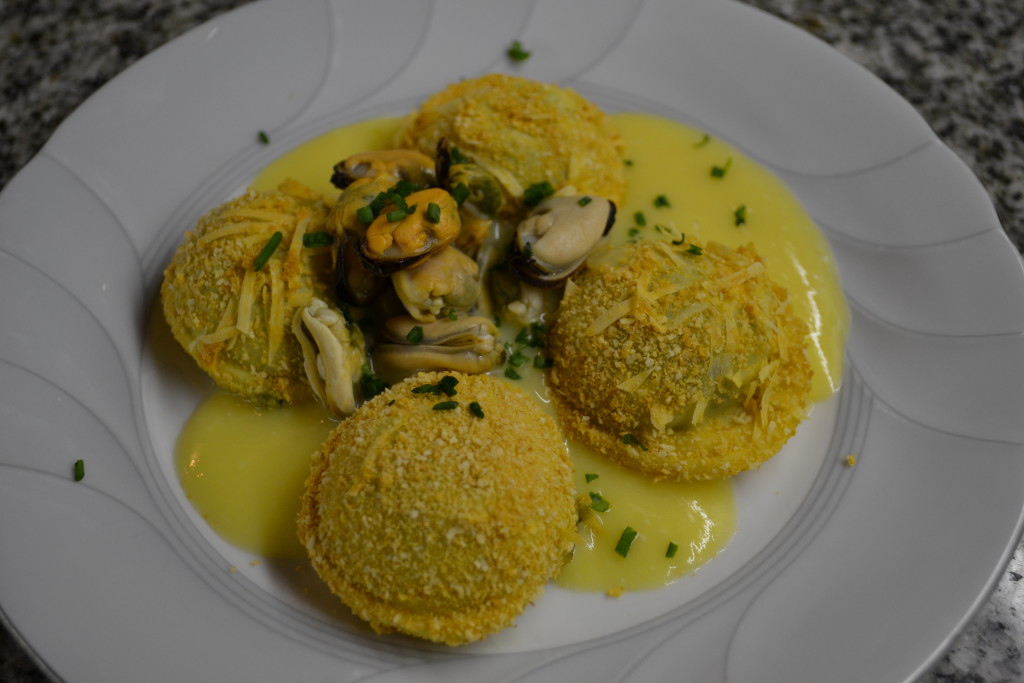On Sunday supplement
Food and Wine
If you haven’t figured out by now, I’m a bit of a pasta fan. I don’t care if they’re long and thin, short and fat, straight, bent or twisted. Toss those noodles with a sauce, vegetables, meats, whatever may occur to you, and likely, I’ll eat it.
Now, if you were to ask most folk about cooking pasta, they’d tell you to boil it up, in salted water, maybe with some oil mixed in. And there’s nothing wrong with that.
But, this weekend, we’re not boiling our pasta. We’re baking it. Baking you say? Why yes – pasta doesn’t have to be boiled – it is after all, simply a dough made from flour and water, often with egg. And, if you stop and consider, lasagna is baked… right there, you’ve baked pasta – though, likely, you gave it a quick parboil first. No, today, we’re simply going to bake it.
This isn’t unheard of. For those of you from the U.S., particularly from, say, the “Show Me State” of Missouri, you might just be familiar with St. Louis Toasted Ravioli. Traditionally, a straightforward meat or cheese filled round of dough, dipped in egg, then in “Italian seasoned” breadcrumbs, deep-fried, tossed in grated parmesan (which may or may not also be mixed into the breadcrumbs), and then served up smothered in marinera sauce.
The Italians, too, make a fried ravioli – seadas – a traditional cheese filled and honey and grappa soaked dessert pasta. But, we’re talking fried here. What about all that baked? For those who want to cut out a bit of the whole deep-frying fat thing, these work out just perfectly when treated to oven cooking. And, I’ll also throw in a twist on those traditional Italian flavors – we’re going to finish these with a lemon sauce and some fresh mussels.
I’m going to trust, for this column’s purposes, that you can come up with some fresh pasta sheets, either homemade or store-bought. You’ll need about 250 grams.
Baked Ravioli
250 gm feta or ricotta cheese
250 gm fresh spinach leaves, washed and coarsely chopped
1 medium onion, chopped
2 tablespoons olive oil
salt, black pepper, nutmeg
Saute the onion in the oil until soft and just starting to color. Add the spinach and cook until well wilted. Add the crumbled cheese and mix well. Season to taste – if you use feta, which I recommend, you’ll need very little salt. Let the mixture cool and fill the ravioli, sealing them well – try to avoid air pockets – when deep-frying or baking, these have a tendency to expand quickly and you end up with a ravioli blow-out. You should end up with a couple dozen ravioli.
2 eggs
100 ml milk
200 gm breadcrumbs (approximately)
100 gm grated parmesan
Mix the breadcrumbs and parmesan. Separately, lightly beat together the eggs and milk. Dip each ravioli into the egg mix, then into the breadcrumb cheese mix, and then place on a lightly oiled baking tray (or, better yet, on a silicone baking sheet. Into the oven with the tray at 200̊C, a fairly hot oven, and bake until golden brown, about 20 minutes.
Sauce
2 eggs
juice of 2 lemons
5 tablespoons hot stock
Beat the eggs for 3 minutes in a mixer, until just starting to thicken and lighten in color, then beat in the lemon juice. Slowly add the hot (not boiling) stock, beating at the same time. Keep warm, but not too hot or the eggs will curdle.
And, finally, to round the dish out, if you’d like a little seafood with it, my favorite, and simplest preparation of mussels.
1 kg fresh mussels, washed well and de-bearded
10 gm ground black pepper
Put mussels and black pepper in a large pot, cover, no added liquid or anything else. Put over a high flame, and cook for 5-6 minutes, until the mussels all steam open in their own juices. Delicious on their own with some crusty Italian bread, or, as here, remove them from their shells and serve along with the ravioli and lemon sauce.
A series of recipes and articles that I started writing for the Buenos Aires Herald Sunday supplement, Food & Wine section, at the beginning of 2012. My original proposal to them was to take local favorite dishes and classics and lighten them up for modern day sensibilities. We’re not talking spa or diet recipes, but at the very least, making them healthier in content, particularly salt, fat and portion size. As time went by, that morphed into a recipe column that, while emphasizing food that is relatively “good for you”, wasn’t necessarily focused on local cuisine. At the beginning of 2013 I decided to stop writing for them over some administrative issues, but it was fun while it lasted.
